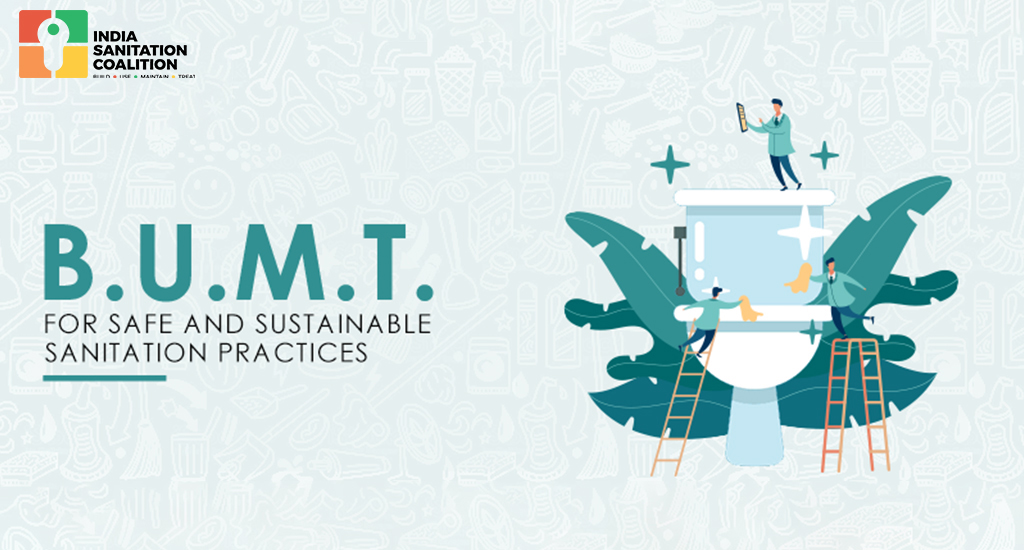Implementing Sustainable Sanitation Through BUMT Model

In India, 'Sanitation' was a hushed subject, an ignored topic, which, if ever slipped into the conversation, people made sure to sweep it back under the carpet of oblivion. For progress of the nation, addressing sustainable sanitation and hygiene practices became essential, and ignoring it further was not an option.
Till 2014, regardless of the government's vigorous efforts, India confronted a grim situation, access to the household toilets was limited to under 40% of the overall population. The 'Swachh Bharat Abhiyan' or 'Clean India Mission' in 2014, initiated by the newly elected government, was a revolution in toilet building and aimed to improve the sanitation coverage despite years of trying. After coming to power, the government pledged to amend the reputation of the country once again, which was followed by investing billions of dollars.
As of 2019, India's sanitation coverage mushroomed to a significant percentage, and many states and cities even achieved the title of “ODF Free.” Thus, a problem that was once neglected by the citizens gained the interest of the nation through relentless and robust campaigning. Every district, city, and state set their individual targets in an attempt to combat the serious problem of providing adequate sanitation facilities and poor handling of sewer and wastewater generated by millions of citizens in rural and urban India.
In a country, that has been greatly influenced by Bollywood, stars like Amitabh Bacchan and Akshay Kumar were roped in to assist in shifting attitudes. Movies like 'Toilet- A Love Story' played a meaningful part in promoting the biggest toilet building campaign. It addressed the issue of lack of toilets, which lead to critical public health concerns. This was a smart and welcoming move that strengthened the national government's campaign and brought in more awareness.
The national toilet building project under Swachh Bharat Abhiyan also marked the end of struggle for the women of the country who put their dignity and safety at stake by compromising and defecating openly. For women residing in rural parts of the country, this was embarrassing and belittling. As there were no toilets built inside the house, the women had minimal options but to adhere to open defecation.
To defecate, women didn't have any alternative but to walk to the distant fields strictly before sunrise or after sunset so that their privacy was not jeopardized. Several women would go together in large groups, usually in the dark, so that no one could see or recognize them while they excreted in the open.
This was a dangerous struggle as the darkness impacted their ability to see any obstacles that lay in their path ahead clearly. Without the ability to sense and inspect the area they chose for excretion, in the shadows, they would be in a position gambling their life away to dangerous snake bites or poisonous insect bites. Not to miss, the unwanted attention they would get by the men and the fear of assault which lurked now and then resulting in constant uneasiness.
The lack of toilets in the rural schools compelled the young girls to miss school and even drop out. Defecating in the open lead to health problems in menstruating women and pregnant women who were more vulnerable to Urinary Tract Infections.
In rural India, unsafe sanitation also contributed to millions of diarrhea cases, which often claim the lives of young children in conjunction with protein-energy malnutrition. The BUMT design helps in fighting such social stigmas. It focuses on imparting knowledge on the grounds that open defecation is not normal and natural; instead, it is unhealthy and unhygienic. It stresses on the fact that toilet building is not the answer to long-lasting sanitation, but it is inclusive of other elements that stimulate the change.
What Is BUMT?
For making advancement along the lines of sustainable sanitation, 'Building Toilets' is of paramount importance. However, the work is not entirely done, and the change is not permanent by merely building toilets. People need to use the toilets, maintain the toilets, and must treat the toilets to resolve problems, if any. Besides the construction of toilets, change will only permeate by educating every citizen about healthy hygienic behavioural alterations.
The BUMT model refers to four such phases, which involve 'Building Toilets,' 'Use of Toilets,' 'Maintaining Toilets,' and 'Treatment of Toilets' to implement a hygienic sanitation practice. By accepting these vital collaborative behaviours a community and the government can ensure persistent positive changes.
Thus, the fundamentals are clear, for any community that seeks the best of sustainable sanitation, they must be open to practice positive hygiene behaviours. An understanding of the benefits of building and using toilets must be ingrained at the grassroot level. So, it is easier for people to identify the reasons due to which they compromise on their dignity and health.
The BUMT Model ensures safe and sustainable sanitation that empowers healthy individuals and communities with behaviour change being its critical component. After provision of the required service, people must learn its proper usage in order to combat the sanitation challenges and ensure cleanliness. This model mainly focuses on the collective efforts of any community to gain access to a clean and safe toilet.
If properly implemented, it ameliorates the living standards and heightens the social, physical, and economic well-being of the communities. The society is empowered with access to fundamental human rights worldwide, which is 'Sanitation.'
Deciphering Individual Elements of BUMT
Building Toilets
The communities must be triggered to build toilets in an effort to forsake open defecation practice. Toilet building is a crucial step in providing safe and sustainable sanitation to the public.
With proper toilet coverage, individuals can avail the use of private toilets to relieve themselves and avoid the daily discomfort without sabotaging their dignity. It will assure the safety and well being of everyone, especially women and young children who often fall prey to the menaces of lack of (well-functioning) toilets.
Besides privacy, building toilets ensure that people keep their environment clean. The chances are slim, but there is a possibility that defecating outside can bring the waste inside the house or premises through feet of humans or animals and further contaminate food and water bodies.
However, just the mere presence of a toilet in a household is not the yardstick to gauge the success in achieving sanitation. While toilet building must be appreciated but the ultimate goal to achieve open defecation free status must be to bring awareness and educate the rural and urban population, especially the urban dwellers who reside in slums.
There is a notable relationship between sanitation, health, and education. The citizens must be made aware of the why's and how's of using toilets to understand the importance of hygiene & sanitation and practice it the correct way to keep deadly diseases away.
Use of Toilets
Building toilets implement a quarter of the change, and to implement the rest, people must be taught how to use a toilet (the basic steps one must follow). It is vital to assign bodies actively working along the lines of sustainable sanitation who can effectively address the knowledge, awareness, beliefs, and feelings of individuals and communities in parts of the country deprived of the facility.
Such bodies will help in bursting the myths, and pass on the right message, which positively influences the children, adults, and benefit the entire community. With access to better sanitation and adequate knowledge, the barriers that stop people from using toilets can be combated.
Educating people about using the toilet will help bring everlasting change. Once people are made aware and find relevance, they will be encouraged to adopt hygienic behaviour. This will make sure they warm up to the idea of using toilets and avoid skipping them.
Maintaining Toilets
After construction of toilets, it's crucial to understand how to clean a toilet and keep it in decent conditions. There must be clear and consistent efforts in keeping the toilets clean, or else the sanitation development can end up being a failure. People must be taught the essential responsibilities required to keep the toilets sanitised and free of deadly diseases. Access to cleaner toilets is not a luxury but rather a fundamental sanitary need, and if not properly maintained, it's ensued with a comprehensive list of major health risks.
The community members and experts such as health workers must come together to recognise and discuss ways to keep the toilets clean. The people who use the toilets must be encouraged to keep it clean and shining. They should, therefore, be taught that toilet hygiene is a matter of great pride for the entire community. Not only will it bring in responsibility and accountability but also promote the use of toilets amongst them.
In addition to cleaning the toilets on their own after every use, having maintenance units will also significantly benefit the community in adequate toilet maintenance. This will ensure regular cleaning and maintenance that will not only preserve the condition of the structure but will also help in getting rid of the underlying foul smell, which is often a reason why people avoid using toilets.
Treatment of Toilets
When the condition of toilets is such that they are beyond maintenance, special procedures or professional services should be availed for treating the toilets. This will ensure that the toilets are restored to its former condition, and the healthy practice of not defecating in the open is continued.
For toilets to function properly and to manage the generated waste, people must be educated against what to flush down the toilets and what to avoid. For prolonged life of the toilets they must know about the do's and don'ts soon after the toilets are built or installed.
In case the toilets are used by multiple people such as public toilets, these must be cleaned and treated more frequently so that public health, property, and the environment doesn't endure any damage.
As soon as the conditions become grievous, the professionals must be called in for help. They are equipped to inspect the toilet, identify the issue, and take appropriate measures to rectify the established problem. Such quick measures will further help in holding the people back from steering to the older practices and also increase the life of the constructed toilets.
Gist
The national sanitation and hygiene programs through the years have steadily gained momentum and brought in the wind of change. People now are more aware than ever. More and more toilets have been built through the years, and the need for proper maintenance has been addressed. But, the journey to attain sustainable sanitation doesn't end here. Though a significant part of the country is declared ODF free, the concern now shifts to maintaining that status.
For persistent change the focus has to be on behavioural adjustments. Implementing the BUMT design and encouraging the citizens to engage are affirmative steps in achieving sustainable sanitation. Once people understand their responsibility and hold themselves accountable to maintain cleanliness, the mission will be accomplished, and best hygiene and sanitation practices will be propagated further.
